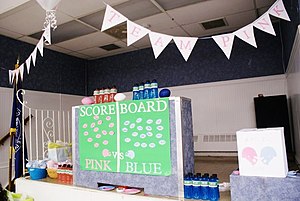Gender reveal party
A gender-reveal party (GRP) is an event or celebration had during pregnancy. The primary goal of this event is the eponymous "reveal" of the fetal sex to the expecting parents, family, and friends. Twentieth century medical advancement in early, reliable prenatal sex discernment has allowed the requisite information that underlies these events to develop.[1][2][3][4]

It is distinct from, but sometimes combined with, a baby shower, whose primary activity is gifting expecting parents with important supplies and items for their future infant's care and well-being. A large variety of methods are utilized, often involving gender stereotypes such as pink and blue.[1][2]
The practice is controversial and has been criticized by many for reinforcing gender stereotypes. The implied binary gender essentialism of the practice has resulted in LGBT, particular transgender, and intersex community criticisms.[1][2][3][4][5]
History and development
A modern creation, the gender reveal party's modern incarnation began in the late 2000s. One of the earliest notable examples was found in the 2008 posts of then-pregnant Jenna Karvunidis on her ChicagoNow blog High Gloss and Sauce announcing the sex of her fetus via cake.[6] YouTube videos of the practice can be found as early as 2008 and 2009, becoming socially significant around 2011, after which the trend continued to grow through the 2010s.[3][2]
In 2019, Karvunidis later expressed regret at having helped start the gender reveal party trend, seeing how far some had taken the trend , learning how the LGBT and intersex communities feel, and finally revealing the daughter they announced back in 2008 to be a gender-nonconforming, tomboyish individual who wears suits while still identifying as female.[6]
Comparison to baby showers
Baby showers, a traditional prenatal celebration, have some key differences with gender-reveal parties. Primarily, the focus on gender-reveal parties is fetal sex, while baby showers focus on the gifting of supplies and items for the future infant to the expectant parent(s). Traditionally, baby showers are for women only, while gender-reveal parties have no inherently-associated gender restriction and attendee limitations (if any) are determined by the pregnant individual or couple. Some couples choose to integrate both events into one for simplicity, efficiency, or economic reasons.[1][2]
Spread and mediatization
The spread of the gender-reveal party trend was and is due to social media such as YouTube, Instagram, and Pinterest, despite the trend originating before the latter two existed.[3][4] This mediatization has significantly boosted the likelihood of expectant parent(s) to have or take part in gender-reveal parties. Internet remix culture lends the practice great receptivity toward individual creativity, a factor in their growing popularity.[1][2] Demographic research shows the most gender-reveal parties are done by expecting parents that are middle-class, heterosexual White Americans whom are married or partnered.[1]
Planning the event
The focus of gender-reveal parties being the fetal sex, such information is a prerequisite. This can be determined at or after the gestational age required by the method being used. For ultrasound, the most common method, the earliest this can be reliably done is approximately 65 days, however is typically done at around 20 weeks[lower-roman 1]. Both the fetal sex and party are typically held during the second trimester.[1][7]
Post-examination knowledge of the fetal sex by the parents varies. Most commonly, a third party (sometimes called a "gender guardian") is entrusted with the fetal sex and it remains a secret from the parents until the reveal. This person is responsible for making party arrangements to ensure the reveal happens without the prior knowledge of the parents. However sometimes, it is known by the parents prior and the reveal to specifically for attendees.[1]
To help maintain the mystery, party decorations are typically heavily-gendered, but ambiguous and androgynous when taken as a whole.[1]

During the event
While the focus remains on the fetal sex, the reveal is typically the climax of the party. Prior to the reveal, party games are common where attendees or expecting parent(s) guess or assert the fetal sex.[1] This can also take the form of competition between a "Team Pink" and "Team Blue" of which parent(s) or participants may form.[1][2]
Sometimes the event includes features of a baby shower. If this is the case, gifts may be given or opened at a specific time before or after the reveal.[1][2]

The Reveal
Most reveal methods utilize gender-associated colors, most typically blue and pink representing male and female respectively, decorated with other gender-associated items. The method of reveal varies, however common methods involve cutting special cakes, launching or popping balloons, confetti/streamers, piñatas, colored smoke, and Silly String. Other seasonally-related items such as Easter eggs, Jack-o'-lanterns, Christmas presents, or Fourth of July or New Year's fireworks may also be incorporated depending on time of pregnancy. [1][2]
Once these colors are revealed, both the expecting parent(s) and onlookers are made aware of the sex of the fetus's genitals, typically to great celebration and comment by attendees. The announcement of a predetermined, sex-dependent baby name can also take place.[1]
Criticism
The sex and gender distinction belies many criticisms of gender-reveal parties.[2] The term "gender-reveal" is considered a misnomer by those who posit the distinction. Gender is a social construct in this view, not attached to any biological characteristics, with an individual gender identity impossible to determine medically. Thus, when a reveal of a fetus's genitals is made, it is the sex and not the gender, that is being revealed according to this view.[2][3][8][5]
Furthermore, gender-reveal parties rely heavily on the male-female gender binary, which assumes the child will not be biologically intersex, which occurs in an estimated 1 in 4500-5500 births.[9][10] Gender-reveal parties reinforce sex and gender assignment and gender essentialism, precluding and minimizing transgender identification, which can cause issues with mental and emotional health.[3][9] Some parents have rejected gender-reveal events because of a greater awareness of gender identity.[11]
Overall the practice heavily reinforces stereotypical gender roles, often utilizing polarizing gender dichotomies in party materials such as "Guns or Glitter", "Pistols or Pearls", or "Wheels or Heels". Critics say that there is no reason to assume that a child would fit neatly into the essentialist dichotomy even where the sex is accurately determined and assigned gender remain the same.[1][2][3][4][5][9]
Individual criticisms
In 2019, Jenna Karvunidis, considered one of the pioneers of gender reveal parties, called for re-evaluation of the practice due to how it might affect transgender and non-binary individuals, also revealing her own daughter's gender nonconformity.[6][12]
Accidents and injuries
Some instances of attempted gender-reveals have caused injury, death, and even large-scale damage. The 2017 Sawmill Fire in Arizona was caused by a gender-reveal party that combined blue powder and an explosive. Other dangerous stunts have involved fireworks and alligators.[13] "Gender reveal burnouts", in which cars emit billowing clouds of pink or blue smoke, are a fad that became popular in Australia around 2018. The Queensland Police Service warns that this practice is dangerous, and that there have been a number of attempted "burnouts" that resulted in flaming vehicles and arrests.[14] In October 2019, an Iowa woman was killed by debris from the explosion of a homemade device meant to reveal her relative's gender.[15]
Notes
- Measured from the onset of pregnancy-induced amenorrhea
References
- Pasche Guignard, Florence (September 2015). "A Gendered Bun in the Oven. The Gender-reveal Party as a New Ritualization during Pregnancy". Studies in Religion/Sciences Religieuses. 44 (4): 479–500. doi:10.1177/0008429815599802. ISSN 0008-4298.
- Gieseler, Carly (February 9, 2017). "Gender-reveal parties: performing community identity in pink and blue". Journal of Gender Studies. 27 (6): 661–671. doi:10.1080/09589236.2017.1287066. ISSN 0958-9236.
- "How Gender Reveals Became Such A Thing". HuffPost. August 16, 2018. Retrieved July 9, 2020.
- Severson, Kim (June 17, 2019). "It's a Girl! It's a Boy! And for the Gender-Reveal Cake, It May Be the End". The New York Times. ISSN 0362-4331. Retrieved July 10, 2020.
- Hafner, Josh (March 12, 2017). "Gender reveals: Insanely popular — and also outdated?". USA Today.
- "Woman Who Popularized Gender-Reveal Parties Says Her Views On Gender Have Changed". NPR.org. Retrieved July 9, 2020.
- Mazza, V.; Falcinelli, C.; Paganelli, S.; Contu, G.; Mantuano, S. M.; Battafarano, S. D.; Forabosco, A.; Volpe, A. (2001). "Sonographic early fetal gender assignment: a longitudinal study in pregnancies after in vitro fertilization". Ultrasound in Obstetrics & Gynecology. 17 (6): 513–516. doi:10.1046/j.1469-0705.2001.00421.x. ISSN 1469-0705.
- "Pink Or Blue, It's All Oversharing: Trendy Parents-To-Be Hold 'Gender Reveal' Parties". www.wbur.org. Retrieved July 10, 2020.
- Nahata, Leena (November 24, 2017). "The Gender Reveal: Implications of a Cultural Tradition for Pediatric Health". Pediatrics. 140 (6): e20171834. doi:10.1542/peds.2017-1834. ISSN 0031-4005. PMID 29175971.
- Sax, Leonard (August 2002). "How common is intersex? A response to Anne Fausto‐Sterling". Journal of Sex Research. 39 (3): 174–178. doi:10.1080/00224490209552139. PMID 12476264.
- Severson, Kim (June 17, 2019). "It's a Girl! It's a Boy! And for the Gender-Reveal Cake, It May Be the End". NYT Parenting. Retrieved July 6, 2019.
- Ho, Vivian (July 26, 2019). "Pioneer of gender-reveal party regrets sparking trend: 'Let kids be who they are'". The Guardian. Retrieved July 26, 2019.
- "Are Gender Reveal Parties Getting Too Extreme?". October 16, 2018. Retrieved July 6, 2019.
- Emily Dixon (July 9, 2019). "Australian gender reveal party goes wrong as car bursts into flames". CNN.
- "Sheriff: Gender reveal party explosion was a stunt gone awry". La Crosse Tribune. October 29, 2019. Retrieved October 30, 2019.
Further reading
- Gieseler, Carly (2018). "Gender-reveal parties: performing community identity in pink and blue". Journal of Gender Studies. 27 (6): 661–671. doi:10.1080/09589236.2017.1287066.
- Nahata, Leena (2017). "The Gender Reveal: Implications of a Cultural Tradition for Pediatric Health". Pediatrics. 140 (6): e20171834. doi:10.1542/peds.2017-1834. PMID 29175971.
- Kotila, Letitia E.; Schoppe-Sullivan, Sarah J.; Kamp Dush, Claire M. (October 2014). "Boy or girl? Maternal psychological correlates of knowing fetal sex". Personality and Individual Differences. 68: 195–198. doi:10.1016/j.paid.2014.04.009. ISSN 0191-8869. PMC 4535729. PMID 26279598.